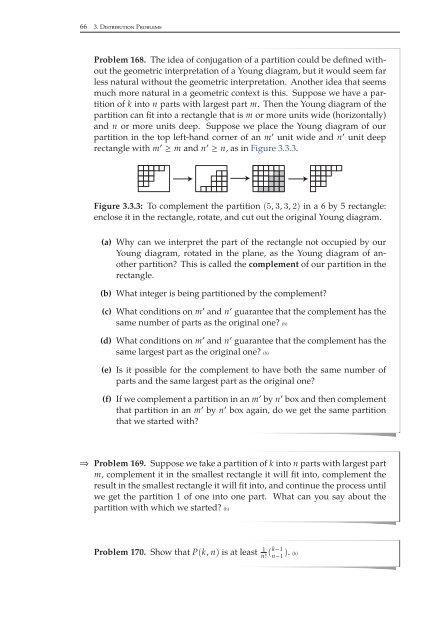Combinatorics Through Guided Discovery, 2004a
Combinatorics Through Guided Discovery, 2004a
Combinatorics Through Guided Discovery, 2004a
Create successful ePaper yourself
Turn your PDF publications into a flip-book with our unique Google optimized e-Paper software.
66 3. Distribution Problems<br />
Problem 168. The idea of conjugation of a partition could be defined without<br />
the geometric interpretation of a Young diagram, but it would seem far<br />
less natural without the geometric interpretation. Another idea that seems<br />
much more natural in a geometric context is this. Suppose we have a partition<br />
of k into n parts with largest part m. Then the Young diagram of the<br />
partition can fit into a rectangle that is m or more units wide (horizontally)<br />
and n or more units deep. Suppose we place the Young diagram of our<br />
partition in the top left-hand corner of an m ′ unit wide and n ′ unit deep<br />
rectangle with m ′ ≥ m and n ′ ≥ n,asinFigure 3.3.3.<br />
Figure 3.3.3: To complement the partition (5, 3, 3, 2) in a 6 by 5 rectangle:<br />
enclose it in the rectangle, rotate, and cut out the original Young diagram.<br />
(a) Why can we interpret the part of the rectangle not occupied by our<br />
Young diagram, rotated in the plane, as the Young diagram of another<br />
partition? This is called the complement of our partition in the<br />
rectangle.<br />
(b) What integer is being partitioned by the complement?<br />
(c) What conditions on m ′ and n ′ guarantee that the complement has the<br />
same number of parts as the original one? (h)<br />
(d) What conditions on m ′ and n ′ guarantee that the complement has the<br />
same largest part as the original one? (h)<br />
(e) Is it possible for the complement to have both the same number of<br />
parts and the same largest part as the original one?<br />
(f) If we complement a partition in an m ′ by n ′ box and then complement<br />
that partition in an m ′ by n ′ box again, do we get the same partition<br />
that we started with?<br />
⇒<br />
Problem 169. Suppose we take a partition of k into n parts with largest part<br />
m, complement it in the smallest rectangle it will fit into, complement the<br />
result in the smallest rectangle it will fit into, and continue the process until<br />
we get the partition 1 of one into one part. What can you say about the<br />
partition with which we started? (h)<br />
Problem 170. Show that P(k, n) is at least 1 n! (k−1 ). (h)<br />
n−1


















